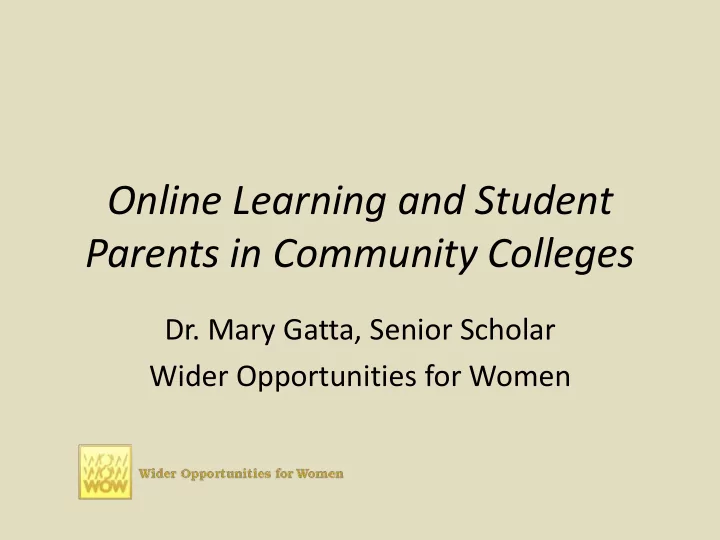

Online Learning and Student Parents in Community Colleges Dr. Mary Gatta, Senior Scholar Wider Opportunities for Women
Online Learning is Growing… • Sloan-C reports (2011) continued growth in online learning over the decade • Currently over 7 million students take at least one online course • 50% of online students are nontraditional (age 26+) (ITC, 2010) • 63% of online students are female (ITC, 2010)
Online and Student Parents • Student Financial Aid Data (2007-08) – 34% of all students who took distance learning class were parents – Most community colleges reported that while student parents are typically the student they see in online courses; they do not explicitly market to them • In contrast – “for profits” aggressively market to student parents
Google Search — “Single mothers and Online Degrees” • University of Phoenix • Cappella University • APU Online University • Kaplan University • College Grants for Single Mothers • Mother Degrees Online • President Obama wants single mothers to go to school
Online offers opportunities for student parents • Transportation • Childcare • Work schedules • Work at own pace • Continuity of learning • Collaborative learning • Digital content is often less costly than course books • Learning on the technology that is critical to labor market
Success of online learning • Sloan Consortium “no significant differences” • Allen and Seaman (2010)---66 percent of academic leaders rate online learning outcomes same or better than face to face • US DOE, 2009, meta-analysis — student outcomes equal or better
Single Mothers, Online and Workforce • Gatta, 2005 – single mothers provided with computers, internet access and courses via One Stop Centers High retention rate- 128 participants only 11 left the program (92% retention rate). Average wage increase – 14%. Women also entered college and community college programs.
Findings ALL the women felt they would have not have had the opportunity to take courses and increase their technological skills without this online program. Flexibility in Time and Space. – Work around their schedules. – Laptop Computers. Helps alleviate childcare demands. – Age of children is important. – Family literacy effects. Helps alleviate transportation demands. – Access to course not available in local area. Participation in the program increases women’s confidence and self-esteem .
Post-secondary focus is primarily on 4 year schools • Few empirical studies on online and community colleges • Retention rates not as high in online community college classes – Xu and Jaggers (2011)- less likely to complete with 10-15% withdrawal – ITC (2010) – 69% completion rate in online classes – BUT-- students who do not withdraw have similar grades to face-face classes
There are challenges for student parents • ‘Third shift”— self discipline, time management • Access to computers and high speed access • Comfort with technology and technical support • Comfort/understanding of online learning • Isolation • Often need to ‘self select’ into online • Support services are not fully online • Not many fully online degrees
Programs directed to student parents • SUNY Community College system received a NGLC grant to pilot a blended learning program for single parents (Fall, 2011) • Targets 19-26 year old adult low wage parents • Includes a series of interventions to address retention – Cognitive tutor – Diagnostic tools – Learning Concierge – Social networking
Promising Practices • Online portals/consortiums – Illinois Community Colleges Online, Massachusetts Community Colleges Online, Colorado Community Colleges Online, California Virtual Campus (examples) – Allows for schools to share courses with each other; and increase options for students – Pool support services – Faculty collaboration
Promising Practices • Blended/hybrid learning – Not fully online (at least 1/3 of course in person) – Allows for the face-face learning – Blended must be ‘flexible” and locally available – Provide options for child care in blended environments
Promising Practices • Rio Salado College (Arizona) – 48 times a year students can begin a course/eliminates traditional semester – Asynchronous learning – All support services online (tutoring, tech support, advising, career services, etc) – Virtual student center/lounge – Courses available 2 weeks prior – “No Friday” due dates (Monday) – Proctor midterms/finals – locations in malls, with child drop off centers
Promising Practices • Online orientations, assessments and ongoing diagnostic tools – Series of activities to prepare them for online course • Curriculum • Online and degree requirements • Nature of online interaction • Technical equipment/requirements • Expectations • Technical/computer literacy skills • Assessments of learning styles
Promising Practice • Outcome based competency, as opposed to seat time • Accelerated semesters – Western Governors University – Chattanooga State Technical Community College – Bucks County College
Institutional challenges exist… • Courses online, less full degree programs • Students not assessed for technical literacy or learning style • Not all student support services online • Faculty buy-in to develop courses • Expectations of “anytime/place” “round clock supports” • May not be part of community college strategic plan
Policy Issues – Online Learning • Child care subsidies may not cover time online • Challenges with financial aid • Broadband and Internet access availabilty • US DOE rules on online education “Program Integrity” – Gainful employment rule – State authorization rule
QUESTIONS AND COMMENTS
Recommend
More recommend